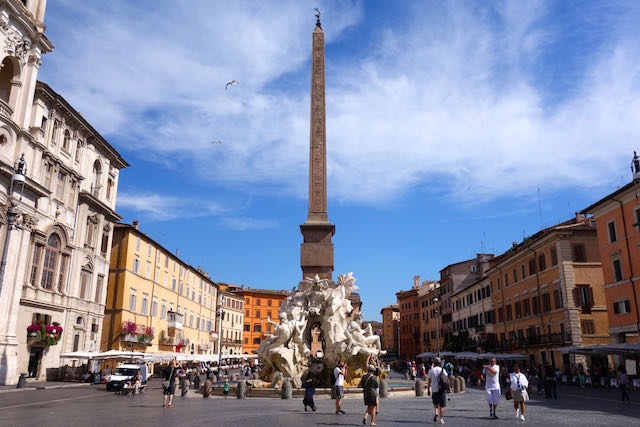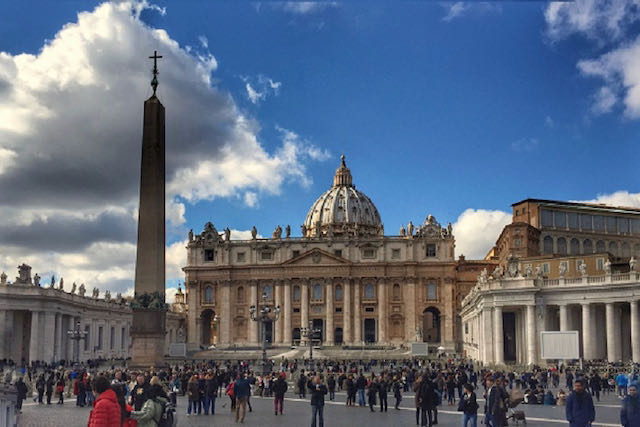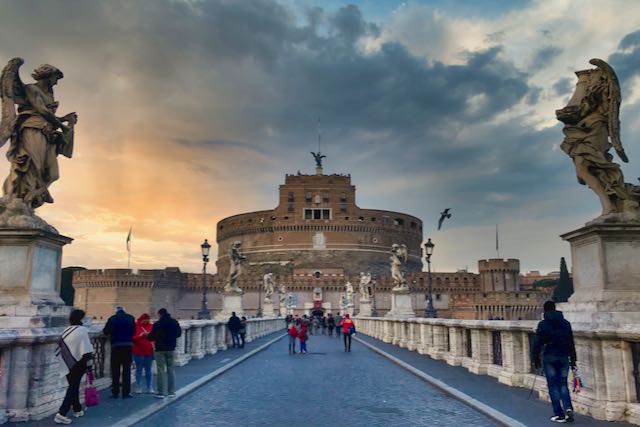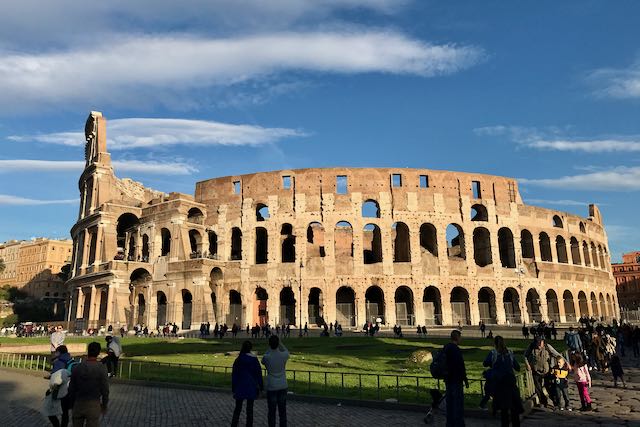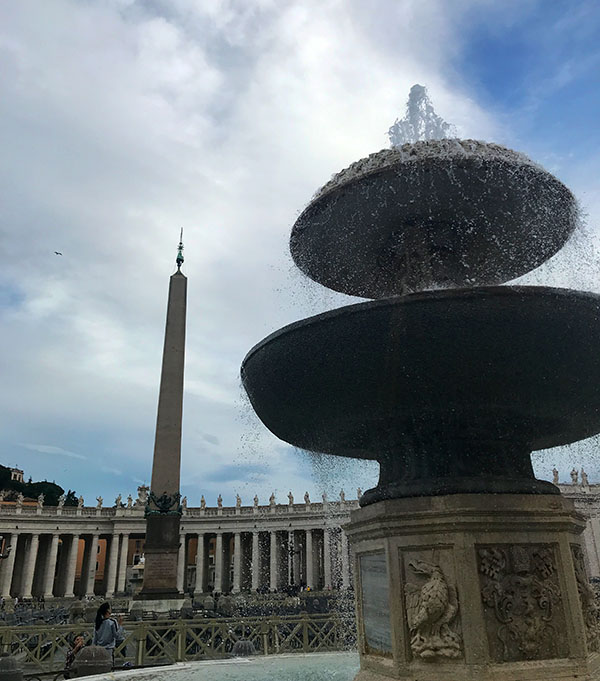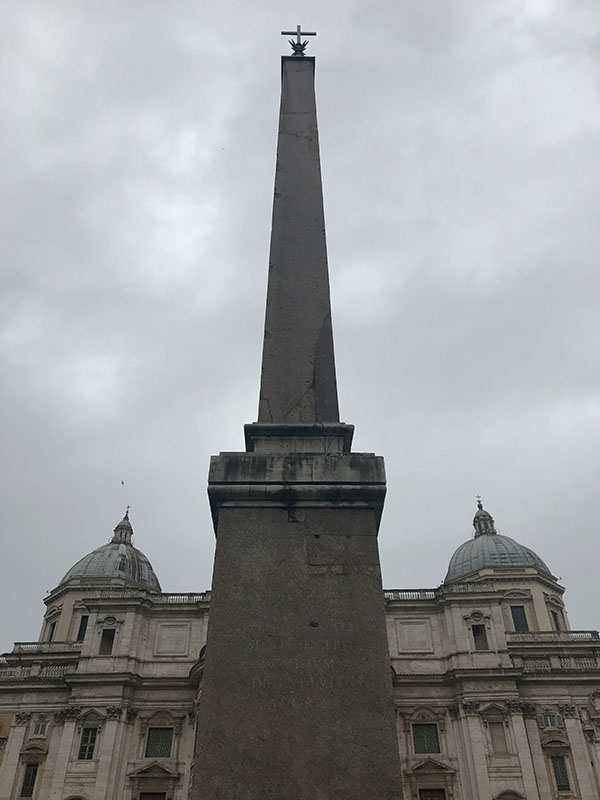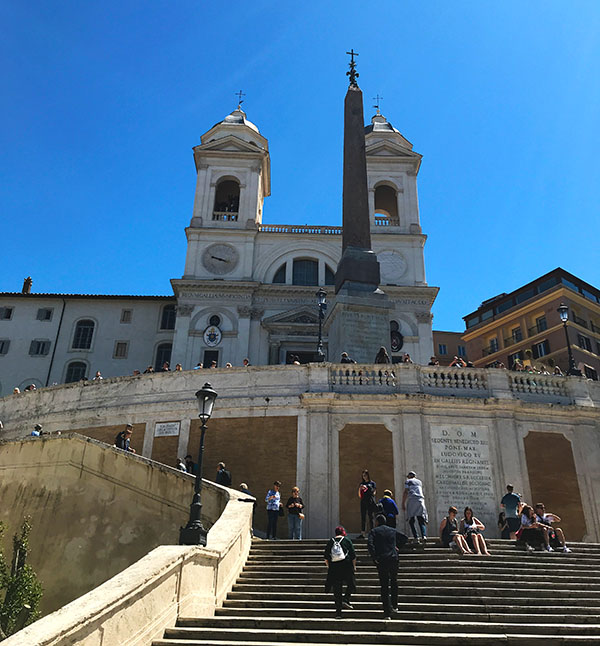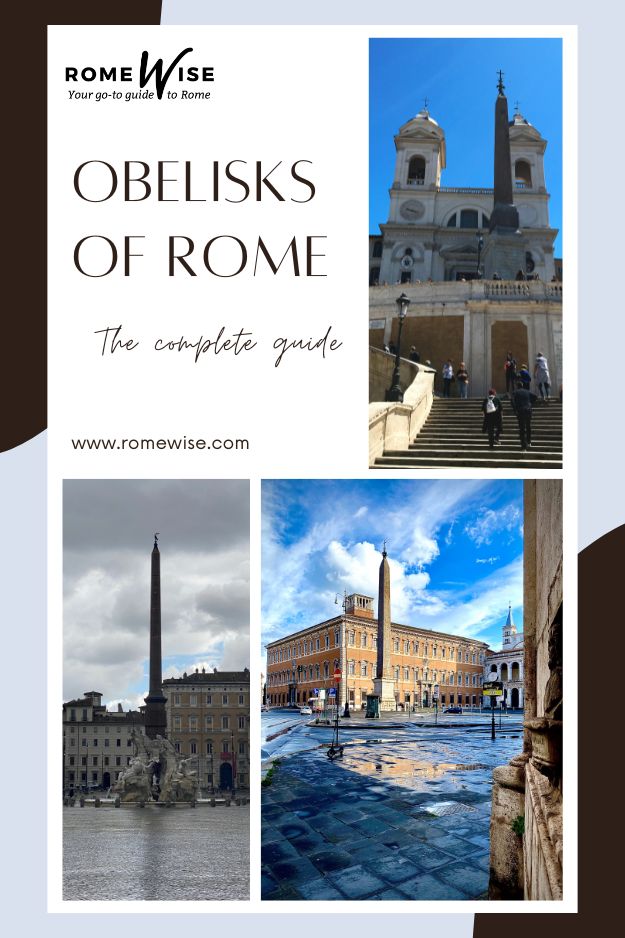- Sign up & get a FREE ebook Subscribe NOW!
- Romewise Home Page
- What to Do in Rome
- obelisks of rome
Discover the secrets behind the obelisks of Rome!
The obelisks of Rome vary from huge imposing structures to small pieces of history, but all provide a fascinating insight into ancient Rome.
Obelisks of Rome - Everything you need to know
Rome is full of obelisks, some are several thousands of years old, and others are much younger.
What is an obelisk and why does Rome have so many?
Find out the answers to these questions and more on this page:
- What is an obelisk?
- How many obelisks does Rome have?
- Why are there obelisks in Rome and what is their significance?
- Original Egyptian Obelisks in Rome
- Ancient Roman Obelisk in Rome
- Other Rome Obelisks
- More Ancient Obelisks
- How to visit and see Rome’s Obelisks
What is an obelisk?
An obelisk is a type of sculptural monument most commonly associated with ancient Egypt.
They are typically tall square pillars that taper into a point at the top, and more often than not are created from a single block of carved stone.
Most often they are used to celebrate or commemorate an individual or a historical event, with writings or reliefs featured on their sides.
How many obelisks does Rome have?
There are a total of 13 ancient obelisks in Rome, eight of which are from ancient Egypt.
Five are later ancient Roman creations.
There are also a handful of ‘modern’ obelisks in Rome, which like their ancient counterparts were created to mark moments in history.
On this page you’ll find a profile of each of Rome’s obelisks, along with details on how to visit them.
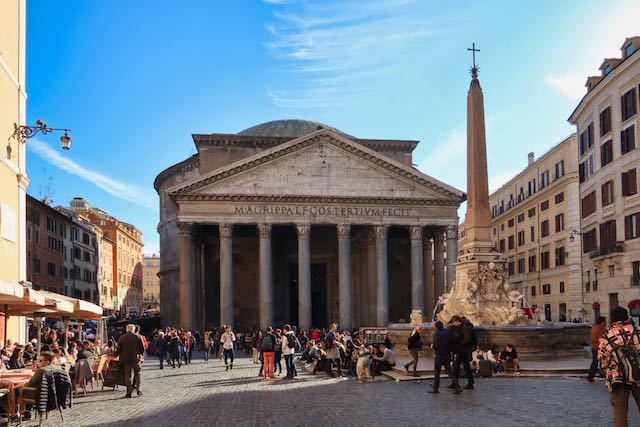 Most of Rome's obelisks fell during the centuries since their placement, but have since been re-erected in the city's most prominent piazzas.
Most of Rome's obelisks fell during the centuries since their placement, but have since been re-erected in the city's most prominent piazzas.The perfect 3-day itinerary in Rome
Trying to figure out how to organize your visit to Rome? I've got the perfect 3-day itinerary for first-time visitors (or those who have not been here in a while.) It works for a 2.5 day visit as well.
In my 3-day itinerary, you'll see all the major must-see Rome attractions like the Vatican, Colosseum, Trevi Fountain, Pantheon, Piazza Navona, Spanish Steps, and much more.
And if you have more time, or want suggestions for extra/other things to do, you'll find that there too.
Visit my page with the best 3-day itinerary in Rome for first-timers.
Why are there obelisks in Rome and what is their significance?
The obelisk ‘trend’ began with Augustus, the first emperor of ancient Rome.
After he annexed Egypt as his own personal property following the defeat of Mark Anthony and Cleopatra, Augustus brought the first obelisks for the imperial capital (the now-called Flaminian Obelisk and Solare Obelisk) from Heliopolis as trophies of this victory.
Over the ensuing centuries other Roman emperors ordered that more obelisks be brought to Rome, but also that local craftsmen create (at that time) modern versions.
It wasn’t until relatively recently (in the grand scale of history) that experts realized that a lot of the obelisks around Rome were not ancient Egyptian originals.
How?
Because the hieroglyphics on the ancient Roman versions didn’t make any sense.
They had just copied the designs from the originals that looked good without any knowledge of their meaning!
Original Egyptian Obelisks in Rome
There are a total of eight original ancient Egyptian obelisks in Rome which were brought here by various Roman emperors – more than you’ll find today in Egypt!
Flaminio Obelisk or Flaminian Obelisk
This is one of the two original Egyptian obelisks brought to Rome by emperor Augustus in 10 BCE from Heliopolis.
It was originally placed on the spina of the Circus Maximus, the raised central area of the track dividing the race course.
After collapsing at an unknown point along with the Lateranense obelisk (more on this below), Pope Sixtus V ordered it be reconstructed in the late 1500s at Piazza del Popolo where pilgrims coming to Rome via the Flaminian Gate would see it as they entered the city.
- Height: 24m
- Period: Pharaoh Seti I/Pharaoh Ramesses (the Great) II
- Location: Piazza del Popolo
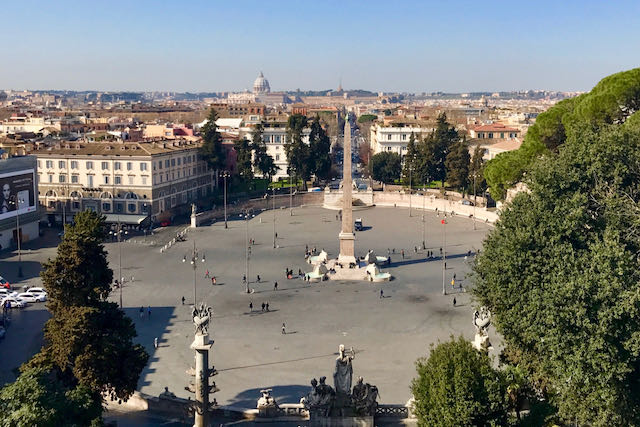 For the best view of the Flaminio Obelisk head up to the terrace overlooking Piazza del Popolo on the Pincian Hill - you'll also find another obelisk up there!
For the best view of the Flaminio Obelisk head up to the terrace overlooking Piazza del Popolo on the Pincian Hill - you'll also find another obelisk up there!Solare or Montecitorio Obelisk
This is the second of emperor Augustus’ two obelisks brought to Rome in 10 BCE.
It was originally used to create the gnomon of the Solarium Augusti in the Campus Martius, a monumental meridian line marker commissioned by Augustus as part of his efforts to elevate Rome’s architectural landscape.
It was lost for an extended period and rediscovered in the late 1700's at which point it was re-erected in front of Palazzo Montecitorio (now the home of Italy’s parliament) under the orders of Pope Pius VI.
- Height: 21.79m
- Period: Pharaoh Psammetichus II
- Location: Piazza di Monte Citorio
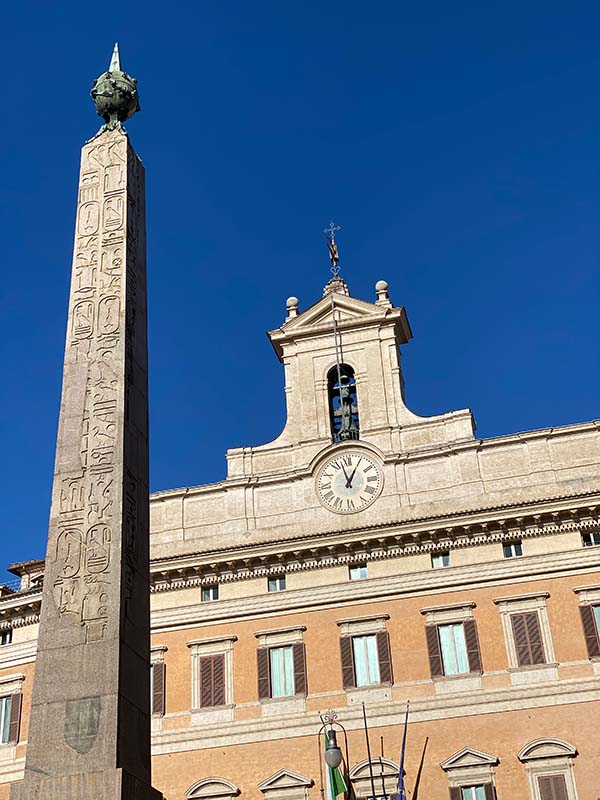 If you look closely you can see at the base of this obelisk where newer sections have replaced the older, lost parts.
If you look closely you can see at the base of this obelisk where newer sections have replaced the older, lost parts.Lateranense Obelisk or Lateran Obelisk
So-called the 'Lateranense' because it now stands in Piazza di San Giovanni at the Lateran Palace (San Giovanni in Laterano), this is Rome’s tallest ancient obelisk.
It was brought to Rome to adorn the Circus Maximus by emperor Constantius II where it had been originally erected at the Karnak Temple in southern Egypt.
Reading the Latin inscription on the base it states that the obelisk marks the spot that emperor Constantine was baptised.
This is not correct, Constantine was actually baptised in Nicomedia in modern day Türkiye.
It collapsed at an unknown point but was re-erected in the 1500's at its current location under the orders of Pope Sixtus V.
- Height: 32.18m
- Period: Pharaoh’s Tuthmosis III & Tuthmosis IV
- Location: Piazza di San Giovanni
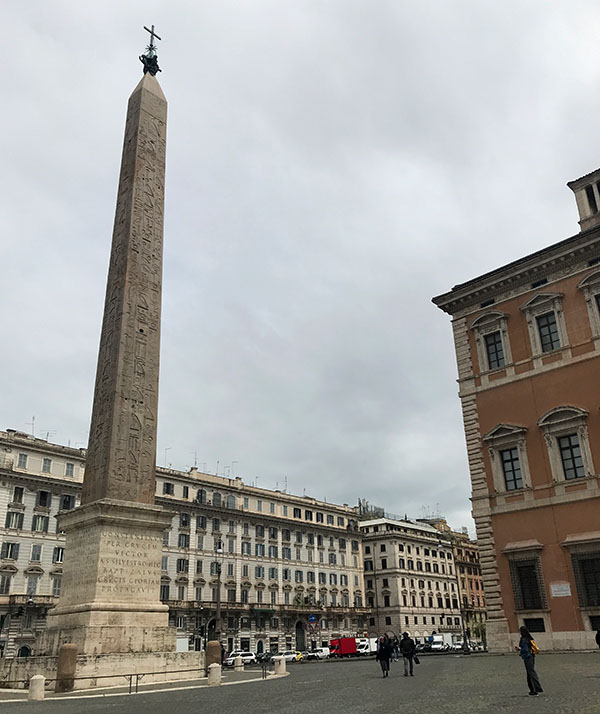 The Lateran obelisk in Piazza di San Giovanni is so huge that you can stand at the Colosseum and look up Via di San Giovanni in Laterano and clearly see it!
The Lateran obelisk in Piazza di San Giovanni is so huge that you can stand at the Colosseum and look up Via di San Giovanni in Laterano and clearly see it!Vaticano Obelisk or Vatican Obelisk
This red granite obelisk was transported to Rome from Egypt under the orders of emperor Caligula in 40 CE, where it was placed in the Circus of Nero, a racetrack and stadium close to the modern location of Vatican City.
This obelisk stood there since ancient times until Pope Sixtus V ordered in 1586 it be relocated the short distance to St Peter's Square.
In ancient times there was a metal orb fixed to the top of the obelisk, which was rumoured in the middle ages to contain the ashes of Julius Caesar.
However, when inspected, no ashes were discovered.
You can see the orb now in the Capitoline Museums.
- Height: 25.5m
- Period: Unknown
- Location: Saint Peter's Square
How did the ancient Romans transport obelisks from Egypt to Rome?
Firstly the Romans likely pulled down the obelisks using soldiers or slaves, lowering it as gently as possible to avoid the stone from breaking.
It's probable that the obelisk was positioned on wooden runners were it would have been hauled to the Nile river, where it would have been loaded on to a transport barge.
From here it would have sailed slowly up the river, and across the Mediterranean Sea before arriving in Ostia, Rome's port.
From here it would have been sailed along the river Tiber to a disembarkation point.
At this stage the process of unloading it and moving it to its new location would have been similar to the process undertaken in Egypt, only in reverse!
Once ready to be erected it's likely the Romans would have used a series of pulleys, winches and cranes (and slave labour) to stand the obelisk up again.
When you visit the Vatican Museums, take a look at the map at the end of the left-hand wall. There you will see a depiction of this event.
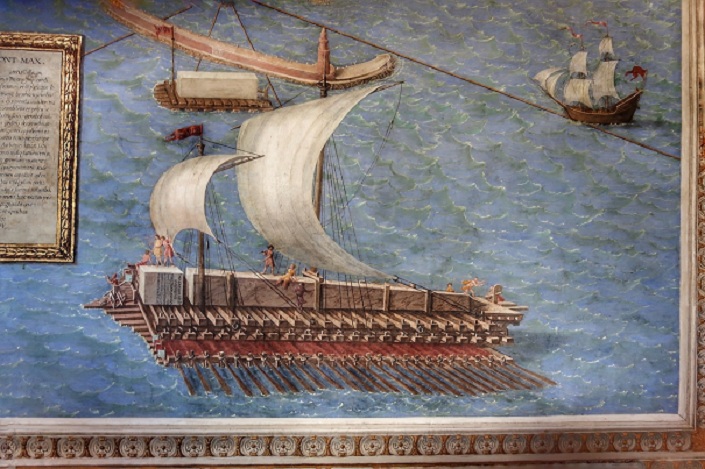
Macuteo Obelisk or Pantheon Obelisk
This obelisk is one of a pair, with the second being the Matteiano obelisk (info below), originally from the Temple of Ra in Heliopolis in Egypt.
It was possibly brought to Rome during the reign of Domitian but this cannot be said with certainty.
During its time in Rome it has been placed at multiple locations.
First at the Temple of Isis near Santa Maria Sopra Minerva, then later at Santa Maria in Aracoeli on the Capitoline Hill (following its rediscovery in the 1300s near San Macuto - hence the name!) before arriving at its current location in Piazza della Rotonda under the orders of Pope Clement XI in 1711.
- Height: 6.34m
- Period: Pharaoh Ramesses II
- Location: Piazza della Rotonda
 Translating the inscriptions you will find phrases that detail the relationship of the pharaoh with the sun god Ra.
Translating the inscriptions you will find phrases that detail the relationship of the pharaoh with the sun god Ra.Matteiano Obelisk
This obelisk is the second of the pair possibly brought to Rome from Heliopolis in Egypt by Domitian.
This is Rome's smallest obelisk, with a large part of the original sculpture lost, it would have been at least as tall as its 'sister' the Macuteo obelisk.
Note when looking at it that only the top half is original.
Like its sister, its original ancient site was at the Temple of Isis and then at Santa Maria in Aracoeli on the Capitoline Hill when rediscovered.
When Michelangelo redesigned Piazza del Campidoglio in the 16th century, the obelisk was lost again before being rediscovered in the 1800's and re-erected in its current location in the grounds of Villa Celiomontana.
This might be my favorite obelisk because of its surroundings; you’ll find it in a very quiet and beautiful (free to enter) park not far from the Colosseum.
- Height: 2.68m
- Period: Pharaoh Ramses ii
- Location: Villa Celiomontana
Note that getting to this obelisk is less obvious than the others, following Google Maps directly will likely lead you to a road nearby, not the exact location.
I know this from my own experience!
As such, enter the Celiomontana park via the entrance on Via della Navicella and then follow Google Maps.
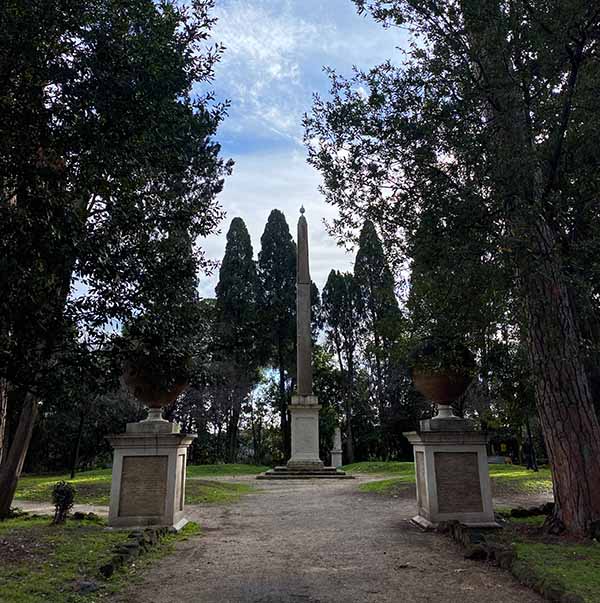 During the COVID lockdowns I used to pass by this obelisk as part of a jogging route when more often than not I'd be only person in the Celiomontana park - a surreal, but memorable experience!
During the COVID lockdowns I used to pass by this obelisk as part of a jogging route when more often than not I'd be only person in the Celiomontana park - a surreal, but memorable experience!Minerveo Obelisk
The obelisk was brought to Rome during the reign of emperor Diocletian, and like the Matteiano and Macuteo obelisks was used to decorate the Temple of Isis.
It is in fact one of a pair, with the second now being in Urbino in the Marche region of Italy.
It was discovered and re-erected (after the obelisk fell at an unknown point) in Piazza della Minerva under the orders of Pope Alexander VII between 1655 and 1657.
- Height: 5.47m
- Period: Pharaoh Apries
- Location: Piazza della Minerva
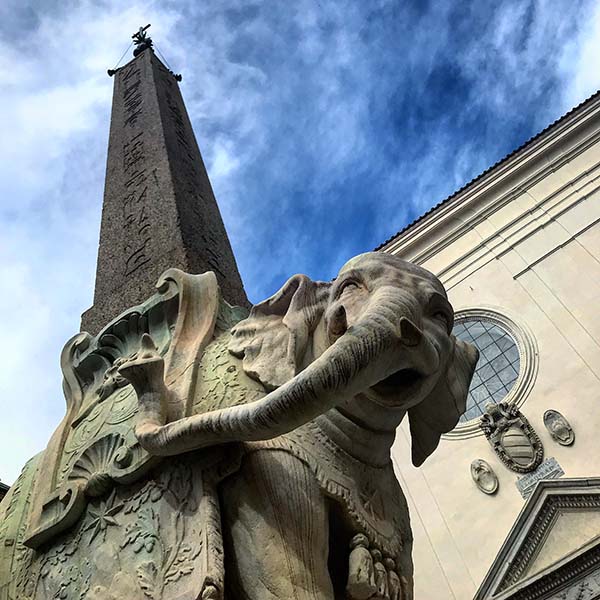 The base on which this obelisk stands in Piazza della Minerva is probably more famous - this happy looking elephant was created by Gian Lorenzo Bernini, the same architect who created St Peter's Square.
The base on which this obelisk stands in Piazza della Minerva is probably more famous - this happy looking elephant was created by Gian Lorenzo Bernini, the same architect who created St Peter's Square.✨ Experience all of Rome's Magic in a Day ✨
Wander through the city's historic center with a local guide, discovering iconic landmarks like the Trevi Fountain, Pantheon, and Piazza Navona — then take a private transfer to The Vatican. Perfect for first-time or hundreth-time visitors, this expertly guided tour reveals the Eternal City’s beauty and rich history at its most enchanting.
Dogali Obelisk
This is probably Rome's most overlooked obelisk as it's found near a main road intersection and Termini train station.
It is originally from Helipolis in Egypt and one a pair, with the second now in the Boboli Gardens in Florence.
After being lost at an unknown point, it was rediscovered in 1884 and erected in its current position in honor of fallen Italian soldiers in 1924.
- Height: 2.74m (approx.)
- Period: Pharaoh Rameses ii
- Location: Via delle Terme di Diocleziano
 I'm not sure what the ancient Egyptians would make of one of their obelisks being placed so close to road traffic and a busy train station!
I'm not sure what the ancient Egyptians would make of one of their obelisks being placed so close to road traffic and a busy train station!Its likely that the small obelisks, such as those at Santa Maria Sopra Minerva or Piazza della Rotunda were originally much bigger, what we see now are just the top sections.
It's possible that the Romans were unable to transport the full obelisks (they may have broken during the dismantling process), or that they just didn’t want to for some reason.
Maybe they did but it has been lost to time.
No one knows for sure, but as a general rule of thumb, these things were HUGE, like the examples at San Giovanni or Piazza del Popolo.
Ancient Roman Obelisks of Rome
Beyond the Egyptian obelisks, you'll also find a number of ancient Roman obelisks in the Eternal City if you know where to look!
These obelisks were created by the Romans in an Egyptian style to evoke the mystique of ancient Egypt and show off their own personal power.
Agonale (Agonalis) Obelisk, Pamphilius Obelisk or Piazza Navona Obelisk
Often mistaken for an Egyptian original, this obelisk was commissioned by emperor Domitian for the Temple of Serapis in Rome.
Emperor Maxentius later moved it to his race track, the Circus of Maxentius on the Appian Way.
It was then relocated and erected on the elaborate Fountain of the Four Rivers in Piazza Navona created by Gian Lorenzo Bernini in 1651 where it has stood since.
- Height: 16.53m
- Period: Emperor Domitian
- Location: Piazza Navona
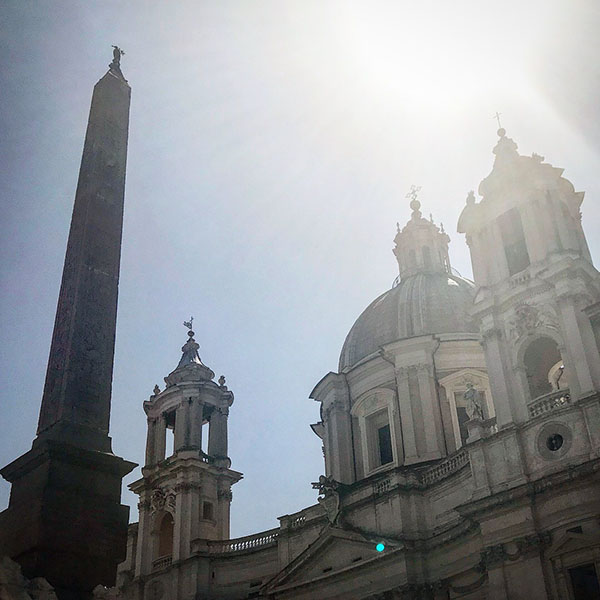 The Agonale obelisk is one of the most striking obelisks in Rome thanks to its position in Piazza Navona.
The Agonale obelisk is one of the most striking obelisks in Rome thanks to its position in Piazza Navona.Quirinale Obelisk or Quirinal Obelisk
This is the first of a pair of obelisks created during the early imperial period of the Roman empire and was used to decorate the Mausoleum of Augustus.
After falling at an unknown point it was found in in the early 1500's but was not raised or repaired until over 200 years later.
Eventually it was moved and re-erected in 1786 under the orders of pope Pius VI on the Quirinal Hill.
- Height: 14.63m
- Period: Early Roman imperial
- Location: Piazza del Quirinale
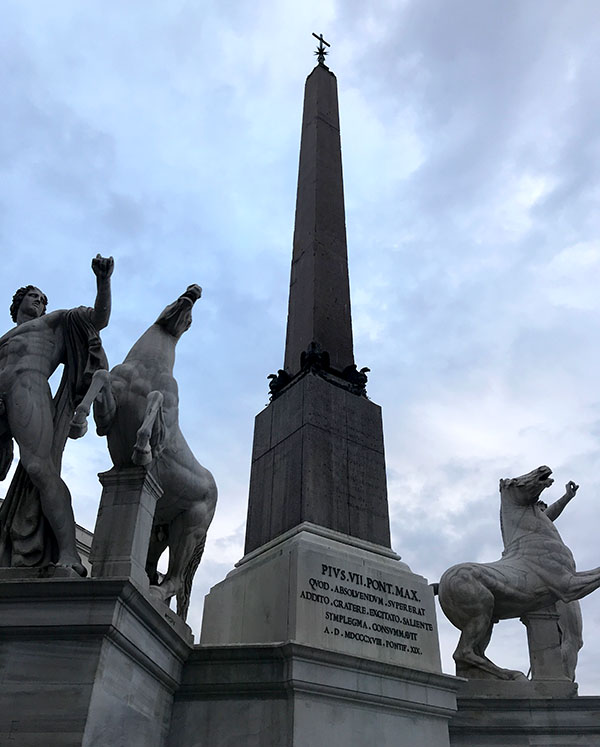 Venturing up to Piazza del Quirinale is worth it not just to see the Quirinale obelisk, but also for one of the most unique views of Rome's skyline
Venturing up to Piazza del Quirinale is worth it not just to see the Quirinale obelisk, but also for one of the most unique views of Rome's skylineEsquilino Obelisk or Esquiline Obelisk
This is the second of the pair used to decorate Roman emperor Augustus' mausoleum.
Reconstructed also in 1527, it was relocated and erected behind Santa Maria Maggiore under the orders of Pope Sixtus V.
- Height: 14.75m
- Period: Early (Roman) imperial
- Location: Piazza dell'Esquilino
Sallustiano Obelisk or Spanish Steps Obelisk
This obelisk is a copy of the much larger Egyptian obelisk in Piazza del Popolo, created during the reign of emperor Aurelian.
It was originally placed in the Gardens of Sallust, a sprawling garden and villa complex created by the famous ancient Roman historian Sallust and then used for centuries by Rome's emperors.
Like most other obelisks, this one fell at an unknown point.
It was found and relocated to Piazza di San Giovanni where it remained horizontal until pope Pius VI ordered it be re-erected at Piazza della Trinità dei Monti, above the Spanish Steps.
- Height: 13.91m
- Period: Aurelian
- Location: Piazza della Trinità dei Monti
If you stand at the intersection of Via 20 Settembre and Via delle Quattro, known as the 'Corner of the Four Fountains', you can see the Esquiline Obelisk, Quirinal Obelisk, and the Sallustian Obelisk!
Pinciano Obelisk or Pincian Obelisk
This is the only obelisk that was not originally intended for placement in Rome itself.
It was created during the reign of emperor Hadrian to decorate the tomb of Antonius at Villa Adriana in Tivoli.
It was later moved by emperor Elagabalus to decorate the spina of the Circus Varianus.
As with nearly all other obelisks, it fell and was lost for centuries.
It was discovered in the 16th century and first moved to Palazzo Barberini, before then being moved again to the Vatican.
Finally it was relocated and erected at its current position on the Pincian Hill under the orders of Pope Pius VII in 1822.
- Height: 9.24m
- Period: Emperor Hadrian
- Location: Viale dell'Obelisco
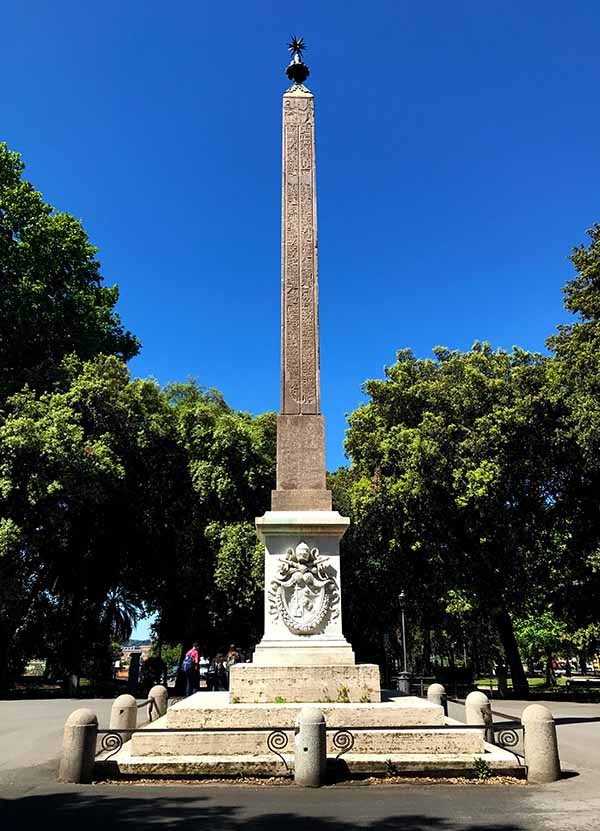 Once you've visited the Pincian Obelisk, walk the short distance to the Pincian terrace where you'll find an amazing view of Piazza del Popolo and the Flaminian obelisk.
Once you've visited the Pincian Obelisk, walk the short distance to the Pincian terrace where you'll find an amazing view of Piazza del Popolo and the Flaminian obelisk.No matter what season you visit Rome, here are 4 essential things we recommend never leaving home without:
Other Rome Obelisks
You'll find a number of more modern obelisks in Rome:
- The Marconi Obelisk in the EUR neighborhood, built in 1959 for the 1960 summer Olympics and dedicated to Guglielmo Marconi, the famous inventor. At 45m tall it is Rome's tallest obelisk.
- Mussolini's Obelisk in Foro Italico, constructed in 1932 and dedicated to Benito Mussolini. This obelisk is particularly striking not just for its history, but for the fact it is made from pristine white Carrara marble.
- In Villa Medici you will find a 19th century replication of the sister obelisk to the Dogali Obelisk, where the original is in the Boboli Gardens in Florence.
- In Villa Torlonia you will find two obelisks created in the 1800's in the classic Egyptian style by Prince Alessandro Torlonia to honor the memory of his parents.
Until 2005 there was also an an Ethiopian obelisk located close to the Circus Maximus in Piazza di Porta Capena in Rome; the Obelisk of Axum.
It was taken from Axum by the Italian army during the second Italo-Ethiopian war in 1937.
After decades of discussions, the obelisk was returned to Ethiopia to its original position where it has remained since.
More Ancient Obelisks
The Egyptian Pharaohs had countless obelisks dedicated to the various Egyptian deities and themselves.
As mentioned previously, other Egyptian obelisks exist in Italy - in the Boboli Gardens in Florence and Piazza Rinascimento in Urbino.
The design of the Washington Monument in Washington DC was inspired by the classic Egyptian style, with the key difference being that the Washington Monument is not made from one single piece of stone due to its size and height.
Another famous obelisk is the so-called Luxor Obelisk in Place de la Concorde in Paris, France.
It is one of two obelisks that were placed by Ramses ii at the Luxor Temple complex, with the second remaining in situ in Egypt to this day.
Ready to plan your trip?
Book your train
Planning to travel between cities in Italy and other parts of Europe?
Use Trainline to see all the different options available across the different rail companies.
Find your hotel
Find your perfect place to stay in Rome.
Use Booking.com to choose between hotels, guesthouses, and self-catering apartments in neighborhoods throughout the Eternal City.
Buy your TurboPass
Purchase the convenient Turbopass and visit all of Rome's top attractions including the Colosseum, Pantheon, and Vatican.
With one handy pass, it's all included.
How to visit and see Rome’s Obelisks
Like a lot of Rome's monuments, all of Rome’s obelisks can be seen for free, just use the info on this page and Google Maps to reach them!
They are all in publicly accessible piazzas where they can be admired up close.
The only one that you may have some difficulty accessing is the Celimontana as the park in which its located is very occasionally closed.
If this is the case, try again the next day!
Before I lived in Rome I used to visit as much as I could, and see as much as I could in the limited time I had.
One of my all-time favorite memories of that period is a day where myself and a good friend visited each original Egyptian obelisk, sequentially, with pit stops for lunch, coffee and spritzes.
We started with the Dogali obelisk which was closest to where we were staying during that trip and followed a clockwise path around the city, but if you wanted to do the same, you could start with any of them!
Romewise's Top Travel Resources
Ready to book your trip to Rome? Take a look at these helpful links to companies we use and trust:
- Keep your travel spending simple with the Wise card, which removes all the worry about exchange rates and high transaction fees all over the world
- Search for and book your perfect accommodation
- Our complete guide to what to pack for Rome
- The number one travel accessory, a multi-point travel adapter and voltage converter
- Browse a huge range of tours in Rome and beyond
- Experience unique tours and special access to Rome's most popular sights
- Protect yourself with comprehensive travel insurance
Within this post there are some affiliate links for products and services. For more details about our affiliate policy click here.
Get your 100% free Rome trip planner now!
Simply sign-up today for our free newsletter and get the Romewise Quick Start guide to Rome:
We are committed to respecting your data. Click for our Privacy Policy.
Comments? Questions? Suggestions?
Please come over to the private Romewise Facebook group and join in the conversation.
You will often find me there, happy to answer your questions / comments!
You will also meet other Rome lovers and experts, too.
What are you waiting for?
- Romewise Home Page
- What to Do in Rome
- obelisks of rome

